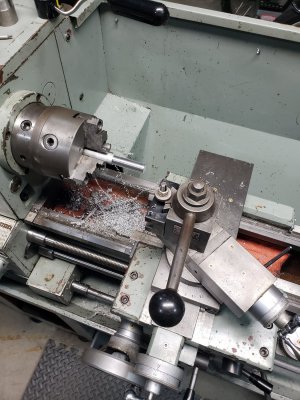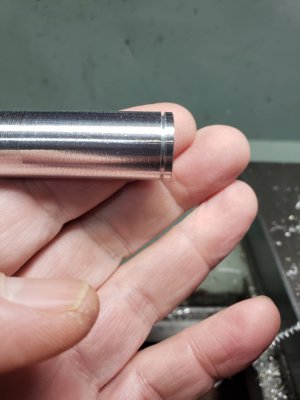-
Welcome back Guest! Did you know you can mentor other members here at H-M? If not, please check out our Relaunch of Hobby Machinist Mentoring Program!
You are using an out of date browser. It may not display this or other websites correctly.
You should upgrade or use an alternative browser.
You should upgrade or use an alternative browser.
I’d like to blame the tool, but…
- Thread starter AlfromNH
- Start date
- Joined
- May 4, 2019
- Messages
- 792
Are you plunge feeding the tool or flank feeding?
I see a fine thread in aluminum that has a lot of burs.
As said before, use some kind of lubrication.
Use a sharp cutting tool. For cutting (aluminum) at low speeds, I use a HSS tool without chip breaker (flat top) and I feed in at 0°. Why, just to get more heat in the chip so the finish is better.
In non work hardening materials, you can cleanup the thread by cutting a few passes at the same cutting depth (cleanup pass).
Some materials just give burs on the thread. Remove them by a file during/after some cleanup passes.
As said before, use some kind of lubrication.
Use a sharp cutting tool. For cutting (aluminum) at low speeds, I use a HSS tool without chip breaker (flat top) and I feed in at 0°. Why, just to get more heat in the chip so the finish is better.
In non work hardening materials, you can cleanup the thread by cutting a few passes at the same cutting depth (cleanup pass).
Some materials just give burs on the thread. Remove them by a file during/after some cleanup passes.
- Joined
- Nov 1, 2022
- Messages
- 140
I’m not familiar with those terms. I’m turning the compound in a few thou before the tool hits the work, then starting the feedAre you plunge feeding the tool or flank feeding?
- Joined
- Dec 18, 2019
- Messages
- 6,464
It appears your compound angle is incorrect. Should be 29.5 (30) degrees from perpendicular. You have it 30 degrees from the spindle axis. Using the spindle axis, as your reference, the compound should be set to 60.5 degrees. So rotate the compound towards perpendicular another 30 degrees. This is a common problem, and exactly why I asked for a photo. I did the same thing starting out...
Having the compound set as in the picture will contribute to tearing.
Having the compound set as in the picture will contribute to tearing.
- Joined
- May 4, 2019
- Messages
- 792
Plunge feed is feeding the tool with the cross slide. Flank feed is feeding the tool with the compound approximately parallel with the trailing flank of the tool. For a 60* thread, that would be feeding at 29.5*. The reason for feeding at 29.5* instead of 30* is so the trailing side of the tool takes a very light cut to eliminate any "steps" in the flank of the thread. At least that is the theory.
A lot of machinists use plunge feed unless the thread is very coarse. I prefer flank feed because I believe it gives better chip flow and reduces tearing. I admit I have never run a test to compare the two methods.
A lot of machinists use plunge feed unless the thread is very coarse. I prefer flank feed because I believe it gives better chip flow and reduces tearing. I admit I have never run a test to compare the two methods.
Last edited:
- Joined
- Nov 1, 2022
- Messages
- 140
Thank you! I’ll correct that before my next attempt.It appears your compound angle is incorrect. Should be 29.5 (30) degrees from perpendicular. You have it 30 degrees from the spindle axis. Using the spindle axis, as your reference, the compound should be set to 60.5 degrees. So rotate the compound towards perpendicular another 30 degrees. This is a common problem, and exactly why I asked for a photo. I did the same thing starting out...
Having the compound set as in the picture will contribute to tearing.
thanks for the definitions. I’m using flank feeding, although at the wrong angle, apparently.Plunge feed is feeding the tool with the cross slide. Flank feed is feeding the tool with the compound approximately parallel with the trailing flank of the tool. For a 60* thread, that would be feeding at 29.5*. The reason for feeding at 29.5* instead of 30* is so the trailing side of the tool takes a very light cut to eliminate any "steps" in the flank of the thread. At least that is the theory.
A lot of machinists use plunge feed unless the thread is very coarse. I prefer flank feed because I believe it gives better chip flow and reduces tearing. I admit I have never run a test to compare the two methods.
Yes, having the compound at a (much)wrong angle will do that when feeding with it. The thread tops essentially become very skinny. Interestingly, it is possible to make a thread like this "work", but it will be very weak and easy to strip.
On the subject of deburring I saw many people use brillo-like abrasive pads. Those never worked for me on a freshly cut thread. I recommend to buy a tiny 60 degree triangular needle file (spend money on it, don't buy cheap Chinese needle files, a file like this will last a lifetime used for deburring threads). Then I run the lathe for the thread to go away from the chuck slowly-no more than 60rpm (so run it reverse on normal thread) and holding the file in your hand put it in the thread so it rides all the way to the end. Repeat few times, then finish with brillo.
Also, when using a file manually, please remove your gloves, jewelery, and raise the cuffs of your sleeves up to your elbows. Many an accident happened with the lathe running slow enough the operator thought its not dangerous. It is. My shop is unheated, so I have to wear long sleeves and a winter coat, but when I put a file to a thread I take it off for those few minutes.
On the subject of deburring I saw many people use brillo-like abrasive pads. Those never worked for me on a freshly cut thread. I recommend to buy a tiny 60 degree triangular needle file (spend money on it, don't buy cheap Chinese needle files, a file like this will last a lifetime used for deburring threads). Then I run the lathe for the thread to go away from the chuck slowly-no more than 60rpm (so run it reverse on normal thread) and holding the file in your hand put it in the thread so it rides all the way to the end. Repeat few times, then finish with brillo.
Also, when using a file manually, please remove your gloves, jewelery, and raise the cuffs of your sleeves up to your elbows. Many an accident happened with the lathe running slow enough the operator thought its not dangerous. It is. My shop is unheated, so I have to wear long sleeves and a winter coat, but when I put a file to a thread I take it off for those few minutes.
- Joined
- May 4, 2019
- Messages
- 792
South Bend, and, I suspect, most American lathe builders set their degree readings so 0* was perpendicular to the bed. It seems the Asian builders set 0* to be parallel with the bed. My rule of thumb is to set the compound so it feeds parallel with the trailing flank of the tool, then move it 1/2* toward perpendicular to the bed.
Unless you are using a carbide full thread insert that cuts the full profile of the thread, the threading tool will likely raise a burr on the crest of the thread. On external threads the burr can best be removed with a file. I use a mill file or long angle lathe file.
Unless you are using a carbide full thread insert that cuts the full profile of the thread, the threading tool will likely raise a burr on the crest of the thread. On external threads the burr can best be removed with a file. I use a mill file or long angle lathe file.



